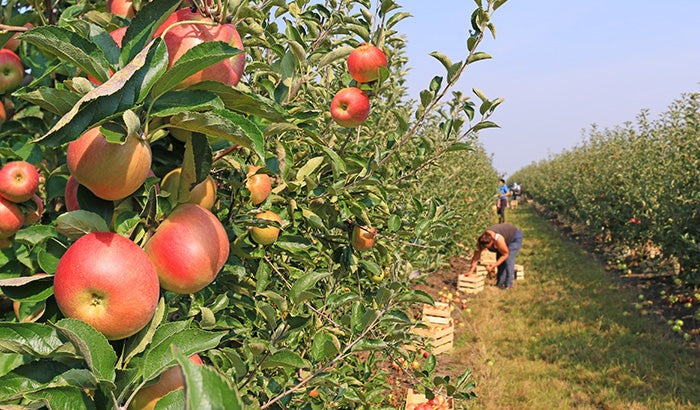5 Things Patio Orchardists Forget
Patio gardening is offering a practical solution for those with limited space to cultivate their own food. Growing fruit trees in containers allows urban and suburban gardeners to enjoy fresh produce without needing expansive plots. However, many patio orchardists, particularly novices, overlook critical aspects that can make or break their success. This article explores five commonly forgotten elements of patio fruit tree cultivation, providing actionable insights to ensure thriving, productive plants. For those seeking quality stock, a nursery specialist from ChrisBowers advises here that selecting healthy, well-grafted trees is paramount to achieving robust yields, and sourcing from reputable suppliers of fruit trees for sale ensures the best start for your patio orchard.
Choosing the Right Rootstock for Containers
One of the most overlooked aspects of patio orcharding is the importance of selecting the appropriate rootstock. Fruit trees, particularly apples, pears, plums, and cherries, are grafted onto rootstocks that control their growth habits, size, and productivity. For patio gardening, dwarfing or ultra-dwarfing rootstocks, such as M27 for apples, Quince C for pears, or Pixy for plums, are essential because they restrict tree size to a manageable height, typically 6-8 feet, ideal for containers. These rootstocks ensure trees remain compact while still producing full-sized fruit, making them perfect for small spaces like balconies or terraces.
Many new growers assume any fruit tree labelled as “dwarf” will suffice, but this oversimplification can lead to issues. For instance, a tree on a semi-dwarfing rootstock like MM106 may outgrow its pot, leading to root constriction and poor health. Without understanding the specific rootstock, gardeners risk purchasing trees unsuitable for long-term container growth. Nurseries offering fruit trees for sale often provide detailed rootstock information, enabling informed choices. Checking this detail before buying prevents the disappointment of a tree that becomes too large or fails to thrive in a confined space. Consulting with specialists or reviewing growing guides can clarify which rootstocks align with patio conditions, ensuring compatibility with limited space and container constraints.
Beyond size, rootstocks influence fruiting timelines and disease resistance. Dwarfing rootstocks tend to encourage earlier fruit production, often within two to three years, compared to standard rootstocks, which may take five or more years. This is a significant advantage for patio growers seeking quicker returns. Additionally, some rootstocks offer resistance to common issues like root rot, which is critical in the often-damp UK climate. Overlooking rootstock selection can result in trees that struggle to adapt, so researching or seeking expert advice is a crucial step often skipped in the excitement of starting a patio orchard.
Understanding Pollination Requirements
Another frequently forgotten factor is the pollination needs of fruit trees. Many varieties, especially apples and pears, are not self-fertile, meaning they require a compatible pollinator nearby to produce fruit. Patio orchardists often purchase a single tree, unaware that it may yield little or no fruit without a partner. For example, an apple tree like Cox’s Orange Pippin needs a different variety, such as James Grieve, flowering at the same time to ensure cross-pollination. Neglecting this can lead to beautiful blossoms but no harvest, a common frustration for beginners.
Pollination groups, which categorise trees based on their flowering periods, simplify the process of selecting compatible varieties. Trees within the same or adjacent groups (e.g., Group 2 or 3) can pollinate each other effectively. However, patio gardeners often fail to check these groups when selecting fruit trees for sale, resulting in mismatched or solitary trees. In small spaces, where planting multiple trees may not be feasible, choosing self-fertile varieties, such as Conference pears or Stella cherries, is a practical solution. These trees can produce fruit without a pollinator, making them ideal for compact patios or balconies.
Environmental factors also affect pollination. Patio trees are often placed near buildings, which can shield them from wind but may limit pollinator access. Bees and other insects are critical for transferring pollen, so a lack of nearby flowers or insect activity can reduce fruit set. Gardeners can mitigate this by planting pollinator-friendly plants, like lavender or marigolds, in nearby containers to attract bees. Overlooking pollination dynamics can lead to years of poor yields, so understanding these requirements and planning accordingly is essential for success.
Proper Container and Soil Selection
The choice of container and soil is another area where patio orchardists often falter. Fruit trees require specific conditions to thrive in pots, and inadequate choices can stunt growth or lead to plant decline. A common mistake is using pots that are too small. For most dwarf fruit trees, a container with a minimum diameter of 18 inches and a depth of at least 16 inches is necessary to accommodate the root system. Smaller pots restrict root growth, limit nutrient uptake, and cause stress, reducing fruit production and overall health.
Drainage is equally critical. Patio gardeners sometimes forget to ensure pots have sufficient drainage holes, leading to waterlogged roots, which can cause root rot, particularly in the UK’s wet climate. A layer of gravel or broken pottery at the base of the pot can improve drainage, but the potting mix itself must be well-draining yet moisture-retentive. A blend of loam-based compost, such as John Innes No. 3, mixed with perlite or grit, provides the ideal balance. Many beginners use generic multipurpose compost, which may lack the structure and nutrients needed for long-term tree health.
Soil fertility is another overlooked factor. Fruit trees in containers rely entirely on the grower for nutrients, as they cannot access the ground’s natural resources. Failing to replenish soil nutrients annually can lead to deficiencies, evident in yellowing leaves or poor fruit quality. Incorporating slow-release fertilisers or top-dressing with compost each spring can maintain soil health. When browsing fruit trees for sale, some nurseries include care guides that detail suitable potting mixes and container sizes, which can prevent these common errors. Choosing the right container and soil sets the foundation for a healthy, productive tree.
Consistent Watering and Feeding Regimes
Watering and feeding are often underestimated in their importance for patio fruit trees. Unlike ground-planted trees, those in containers have limited access to water and nutrients, making consistent care vital. Many patio orchardists forget to adjust their watering schedules based on weather, season, or the tree’s growth stage. Overwatering is a frequent issue, especially in spring or autumn when rainfall is abundant, leading to soggy soil and root damage. Conversely, underwatering during hot summer spells can stress trees, causing leaf drop or fruit abortion.
A general rule is to water when the top inch of soil feels dry, ensuring thorough soaking without leaving the pot waterlogged. Using a saucer beneath the pot can help retain moisture in dry periods but should be emptied after watering to prevent root rot. Mulching the soil surface with bark or gravel can reduce evaporation and maintain consistent moisture levels. In the UK’s variable climate, checking soil moisture regularly rather than adhering to a rigid schedule prevents both extremes.
Feeding is equally critical but often neglected. Fruit trees require regular nutrition, particularly during the growing season from spring to early autumn. A balanced liquid fertiliser, high in potassium for fruit development, should be applied every two weeks during this period. Many growers forget to feed consistently or stop after the first year, leading to nutrient deficiencies that weaken trees and reduce yields. For those sourcing fruit trees for sale, reputable nurseries often provide feeding schedules in their care guides, which can serve as a roadmap for maintaining tree vigour. Establishing a routine for watering and feeding ensures trees remain healthy and productive year after year.
Protecting Trees from Pests and Diseases
Pest and disease management is a final area where patio orchardists often fall short. The misconception that container-grown trees are immune to issues prevalent in traditional orchards leads many to neglect preventative measures. Common pests, such as aphids, codling moths, and spider mites, can still affect patio trees, while diseases like peach leaf curl or powdery mildew thrive in the UK’s humid conditions. Failing to monitor for these problems can result in damaged foliage, reduced fruit quality, or even tree loss.
Peach and nectarine trees, for instance, are particularly susceptible to peach leaf curl, a fungal disease spread by water splashing onto emerging leaves. Covering trees with a plastic sheet during early spring or moving them under shelter can prevent infection. Similarly, regular inspection for aphids or other pests allows early intervention with organic sprays or insecticidal soap. Many patio growers overlook the need for such vigilance, assuming proximity to the house offers protection. However, urban environments can still harbour pests, and crowded patios may exacerbate disease spread due to poor air circulation.
Encouraging natural predators, like ladybirds, by planting companion flowers can reduce pest populations. Additionally, pruning to maintain an open canopy improves air flow, reducing fungal risks. When selecting fruit trees for sale, choosing disease-resistant varieties, such as Liberty apples or Avalon Pride peaches, can minimise issues. Staying proactive with monitoring and protection strategies ensures trees remain healthy and productive, avoiding the disappointment of preventable losses.
Long-Term Planning for Tree Health and Productivity
Beyond these specific oversights, patio orchardists often fail to plan for the long-term health and productivity of their trees. Container-grown trees have a finite lifespan in pots, typically 10-15 years, before they become root-bound or exhaust the soil’s nutrients. Many growers neglect to repot or refresh the soil every few years, leading to declining vigour. Repotting into a slightly larger container or replacing the soil entirely can extend a tree’s productive life. This process, done every three to five years, involves trimming roots and refreshing the potting mix to maintain health.
Pruning is another long-term consideration often forgotten. Dwarf fruit trees require annual pruning to maintain shape, encourage fruiting, and prevent overcrowding. Without this, branches can become tangled, reducing light penetration and fruit quality. Simple cuts to remove dead wood, crossing branches, or overly vigorous shoots can keep trees productive. Many beginners shy away from pruning, fearing they’ll harm the tree, but following basic guidelines or seeking advice from nursery resources can demystify the process.
Finally, seasonal protection is overlooked. Patio trees are more exposed to temperature extremes than ground-planted ones. Wrapping pots in bubble wrap during winter prevents root freezing, while moving trees to a sheltered spot during heatwaves avoids stress. Planning for these seasonal needs ensures trees remain resilient. Nurseries offering fruit trees for sale often include long-term care advice, which can guide growers in sustaining their orchard’s productivity over time.
Conclusion
Patio orcharding offers a rewarding way to grow fresh fruit in small spaces, but success hinges on avoiding common oversights. Selecting the right rootstock sets the foundation for compact, productive trees suited to containers. Understanding pollination ensures fruit set, while proper containers and soil provide the necessary environment for growth. Consistent watering and feeding regimes sustain tree health, and proactive pest and disease management protects yields. Finally, long-term planning through repotting, pruning, and seasonal care keeps trees thriving for years. By addressing these often-forgotten elements, patio orchardists can enjoy bountiful harvests and the satisfaction of homegrown fruit, even in the smallest of spaces.













Post Comment